Manuscript accepted on : 29 June 2012
Published online on: --
Seasonal Variation in Spider Population in the Semi Arid Area of North Gujarat
M. B. Patel1 and M. I. Patel2
1Department of Biology, Navyug Science College, Surat, India.
2Principal M.N. College, Visnagar (Retd.), India.
ABSTRACT: Ecological study of spiders was done in Mehsana district(230 02’ to 240 09’ North latitudes and 710 26’ to 720 51’ East longitudes). Their collection was done from different habitat of four different sites for two years. Study area comes under semi arid climate. Its vegetation region has been classified as “Indian desert”. Pit-fall trap methods as well as Sweeping method were applied for spider collection. Low species population was available during cold period (December-January) and high in Early Monsoon (June-July). Temperature effects highly and photoperiodism effects moderately on availability of spider species. More number of families also recorded during Monsoon. Hippasa pisaurina, Pocock was a predominant species in this area. Species richness was recorded highest during post Monsoon and Early Monsoon. Available different food source from farmland habitat during crop calendar was marked with its dominant role for diversity of spider fauna. But it was observed that use of insecticides in Ravi crops effect on population of spiders due to common agriculture practice. Public awareness about spiders as a bio controller is required.
KEYWORDS: Habitat; Monsoon; Agriculture; Species Richness; Temperature
Download this article as:| Copy the following to cite this article: Patel M. B, Patel M. I. Seasonal Variation in Spider Population in the Semi Arid Area of North Gujarat. Biosci Biotech Res Asia 2012;9(1) |
| Copy the following to cite this URL: Patel M. B, Patel M. I. Seasonal Variation in Spider Population in the Semi Arid Area of North Gujarat. Biosci Biotech Res Asia 2012;9(1). Available from: https://www.biotech-asia.org/?p=9693 |
Introduction
According to the latest estimates, approximately 37,300 species of spiders belonging to 3450 genera and 108 families are known from all over the world. Over 1000 species of them are so far known from the Indian sub continent (Smith 1982). Investigation on spider is very important because it is a best biological controller (Wheeler 1973; Turnbull 1973). It is a best adaptive creature to nature. They found extensively in fields, thick forest floors, gardens, tree trunks, human habitation, mostly in deserted buildings, in creeks of wall, under stones, loges, ground, etc.
A new multidisciplinary science that has developed to deal with the crisis is conforming biological diversity or conservation biology. With respect to this we have selected the topic which is less attended by scientist and naturalists.
Study Area
The state of Gujarat is situated on the West coast of India and lies between latitudes 10.1o N and 24.7oN and longitudes 68.4o E and 74.4o E (Fig 1). The main land is almost flat plain made up of alluvial soil and some sandy soil in the North. The climate of north Gujarat is tropical in nature as the tropic of cancer passes through it. There is a large spatial and temporal variation in rain fall. Area Mehsana district (23o 02’to 24o 09’ North latitudes and 71o 26’ to 72o 51’ East longitudes) of Gujarat was selected for study. Total different four sites were selected for collection with respect to different habitat: urban area, hilly forest area, crop field area, open westland area. Winter (November- January) is a period of cold and summer (February- June) is a hot period in the district. Monsoon starts during June and extends up to October. Average % relative humidity ranged 43.57 to 86.60 during study period (Table 1, Fig 2). Average highest rainfall remained during Late Monsoon (321mm) and low during Post Monsoon (25mm). Moisture status was remained dry during Winter and Early Summer but varied during Late Summer and Post Monsoon (Table 2). Winter has very short photoperiod (average 11-19 hrs) and later on it increases. Highest photoperiodism remains during Early Monsoon (average 14-12 hrs). Vegetation of a district has been classified as “Indian desert” by Clarke (1898). Various types of crops grown. Sowing and harvesting seasons of cereals and pulses in a study area spread almost entire year, except April, May, June and September (Table 3).
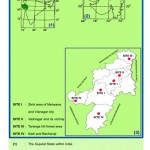 |
Figure 1: Map of the study area.
|
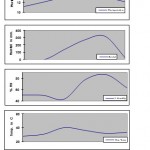 |
Figure 2: Average climatic factors and species population in a study area.
|
Table 1: Available spider species and their relation with climatic condition in a study area with r value *
| Season | Available | Average | % | Rainfall | Photo |
| Species | Temp.°C | Humidity |
in mm |
period
Hrs |
|
| Winter | 18 | 20.51 | 50.58 | 0 | 11 19 |
| Early Summer | 23 | 22.41 | 50.19 | 0 | 12 10 |
| Late Summer | 49 | 31.69 | 43.57 | 140 | 13 11 |
| Early Monsoon | 58 | 31.64 | 77.66 | 271 | 14 12 |
| Late Monsoon | 46 | 28.79 | 86.60 | 321 | 13 14 |
| Post Monsoon | 61 | 27.13 | 63.10 | 025 | 12 15 |
* Calculative Values based on species population of spiders Vrs. different factors
Factors r Value Conclusion
Available Sps. Vrs. Average temp. + 0.85 Fairly Correlated
Available Sps. Vrs. % Humidity + 0.48 Low Correlated
Available Sps. Vrs.Rainfall + 0.52 Moderate Correlated
Available Sps. Vrs Photo Periodism + 0.70 Moderate Correlated
Table 2: Moisture status during different years*
| Season | Climatic
|
Condition
|
|
| Years | |||
| 2003
|
2004
|
2005
|
|
|
Winter |
Dry |
Dry |
Dry |
| Early summer
|
Dry | Dry | Dry |
|
Late summer
|
Dry |
Humid |
Dry |
|
Early monsoon
|
Humid |
Per humid |
Humid |
|
Late monsoon
|
Humid |
Humid |
Humid |
|
Post monsoon
|
Dry |
Semi dry |
Dry |
*Note: The moisture status for a month is categorized by the following
formula,
Dry – P≤2T
Semi dry – P>2T or ≤3T
Sub humid – P>3T or ≤4T
Per humid – P>4T or ≤5T
Humid – P>5T
Where P stands for the monthly precipitation in mm and T stands for the
monthly mean temperature in degree centigrade.
Table 3: Crop calendar (Related to spider fauna).
| Name of | Month of | Month of |
| the crop | Sowing | Harvesting |
|
Bajari |
Jul. |
Oct. |
| Castor | Aug. | Jan. |
| Cotton | Jul. | Feb. |
| Jowar | Aug. | Dec. |
| Mustard | Oct. | Jan. – Feb. |
| Paddy | Jul. | Oct. – Nov. |
| Rape | Oct. | Jan. – Feb. |
| Tobacco | Aug. | Feb. – Mar. |
| Tur | Jul. | Nov. – Dec. |
| Wheat | Nov. | Mar.
|
Insect fauna was observed in luxurious number and variety during Monsoon. Some of them are the pest of cereals and pulses. Total 37 insectivorous bird species was seen during study period.
There are six seasons in this area. Summary of each season of a district is given in a (Table 4). It gives climatic condition and a specific remark of each season.
Table 4 Summary of each season in a Mehsana District.
|
Season |
Climatic condition |
Remarks |
| & Month | ||
| 1. Winter | Period of cold weather | Highly |
| Dec. to Jan. | The sky remains clear | available |
| Precipitation of rainfall is rare | Avian | |
| Fauna | ||
| 2. Early Summer | Starting period of warm weather | Harvesting |
| Feb. to Mar. | Summer starts from late Feb. | Period for |
| Transitional period between Winter and | Ravi crop | |
| Summer | ||
| Nights remain cool & days warm | ||
| Usually sky remains clear but some time | ||
| clouds were seen | ||
| Dry period | ||
| Rainfall was hardly recorded | ||
|
3. Late Summer |
Period of warm and dry weather |
Very hot |
| Apr. to May | Temperature did not drop bellow 170 C | season, |
| Dry period | Open | |
| farmlands | ||
| 4. Early Monsoon | The South-West Monsoon starts from late | Availability |
| Jun. | of insects | |
| Jun. to Jul. | Climate was humid but it was per humid in | (larval |
| 2004 | stage) was | |
| high | ||
| 5. Late Monsoon | Climate was more variable, humid to dry | High |
| Aug. to Sep. | number of | |
| insect fauna | ||
| 6. Post Monsoon | A transitional period between the Monsoon | Sowing |
| Oct. to Nov. | & Winter | period for |
| Dry period but it was semidry in 2004 | Kharif crops |
Collecting Method
Spiders were collected mostly by hand. Searching was done by jerking the twigs of trees and bushes, keeping inverted open umbrella below to collect fallen spiders. They were kept in plastic tubes (5cm x 2cm) containing 70 ethanol and a slip indicating date and place etc. They were also collected by pit-fall trap method and sweeping method. Pit-fall trap method helps to capture non-weavers. Ditches (10 to 15 cm) were made and put the plastic dish (10 cm wide) filled with ethylene glycerol. Sweeping method was operated at early morning or at evening. The sweeping net (60 cm long and 24 cm wide) was operated at crop fields, farms, or ground and tall grasses. Spiders from net were collected and preserved in the containers. Identification key was adopted (Patel 1985).
Formulae used to study
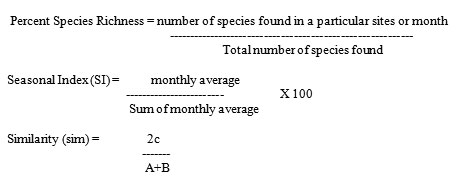
Results and Discussion
Preference of habitat
Total 1200 specimens were collected. Out of total collected samples 551 samples were from Farmland, 321 from Wetland, 216 from Wasteland and 120 samples from houses (Table 5). Collected samples belong to 18 families (Table 6). Family Lycosidae and Therididae prefer wetland. Arenididae family is restricted to farmland only, other members of family Oxyopidae and Thomicidae were also found in Farmland habitat. Members of families Heteropoidae and Eresidae prefer Wasteland ecosystem. But members of Pholicidae were marked in a human habitation, especially at the corner side of the houses (Table 6). Nescona theis ,Oxyops ratna and Tibellus pateli prefer vegetative farmland habitat near wasteland area. Similarity index shows that there was a high degree similarity between farmland and wetland species, but no similarity among habitat between farmland and westland due to variation in vegetation (Table 7).
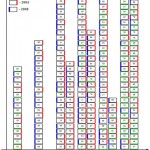 |
Figure 3
|
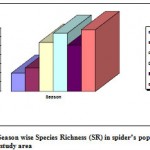 |
Figure 4: Season wise Species Richness (SR) in spider’s population of the study area.
|
Table 5: Spiders available from different habitat within the study area.
|
Habitat |
No. of samples
|
% Selection
|
|
Farmland |
552 |
46 |
| Wetland | 312 | 26 |
|
Wasteland |
216 |
18 |
| Houses | 120 | 10 |
| Total | 1200 | 100 |
Table 6: Family wise habitat selection within the study area.
| Family | (Number of samples) | |||
| Farmland | Wetland | Wasteland | Houses | |
| Amaurobiidae | 00 | 00 | 026 | 00 |
| Araneidae | 144 | 00 | 00 | 00 |
| Clubionidae | 041 | 00 | 00 | 00 |
| Eresidae | 00 | 00 | 059 | 00 |
| Gnaphosidae | 031 | 00 | 00 | 00 |
| Heteropoidae | 00 | 00 | 071 | 00 |
| Lycosidae | 031 | 222 | 00 | 001 |
| Oeicobidae | 00 | 00 | 00 | 020 |
| Oxyopidae | 084 | 00 | 00 | 00 |
| Pholicidae | 00 | 00 | 00 | 058 |
| Pisauridae | 00 | 00 | 009 | 001 |
| Salticidae | 028 | 00 | 006 | 014 |
| Scytodiidae | 00 | 010 | 00 | 00 |
| Selenopidae | 00 | 00 | 00 | 005 |
| Theridiidae | 00 | 063 | 00 | 00 |
| Thomisidae | 082 | 00 | 00 | 00 |
| Uloboridae | 037 | 00 | 00 | 00 |
| Urocteridae | 00 | 010 | 027 | 00 |
| Dried samples* | 070 | 007 | 018 | 021 |
| Very small sized sample * | 004 | 00 | 00 | 00 |
| Total | 552 | 312 | 216 | 120 |
Table 7: Degree of similarity of habitat preferred by spiders in a study area.
|
Sites
|
Similarity Index | Degree of Similarity |
| Site I & II | 0.25 | High |
| Site III & IV
|
0.21 | High |
| Site I & IV | 0.13 | Moderate |
| Site II & III
|
0.12 | Moderate |
| Site II & IV | 0.11 | Moderate |
| Site I & III
|
0.08 | Low |
Season variation
Figure 2 shows season wise available samples within three years (2003-2005) in a study area. Year wise as well as in toto of three years indicate that very low species population was available during cold and dry period. i.e. during Winter and Early Summer. Maximum numbers are found during Early Monsoon (412 out of 1200).
There is an influence of average temperature on available species(r=+0.85).It is fairly correlated relative percent humidity dose not effect (r= +0.48). Rain fall is not a direct effective factor but during raining insect fauna and vegetative growth found maximum,so food is the ultimate factor. Very little research has been conducted on the feeding ecology of spiders, perhaps due to difficulty of observing predation by these vagrant spiders in the field (Bredy 1964). Photoperiodism moderately effects (r=+0.70) because spider groups show both types of activities i.e diurnal and nocturnal. Even web preparation take place at night. Subramanyam(1940)studied on Indian spider and reported that the members of families Argiopidae, Sparassidae, Clubionidae, Psechridae,Lycosidae and Oxyopidae become active at the onset of Monsoon. Scott et al (1983) reported that the population of a family Oxyopidae remained low on cotton before the rain fall but there number increased with the onset of Monsoon. In our collection also it is seen as same as they observed. Barghusen et al (1997) had suggested that temperature has influence on web-building behavior in common house spider Achaearanae tepidariorum. They have concluded that spiders are ectothermic in both their metabolic rate and their activity levels vary with temperature. In tropical region effects of temperature was studied by patel and Kareemallah(1989) on two species of pseudo scorpion and observed that the number of hibernation chambers significantly increased the time in culture by factor of low temperature. In the district the daily average minimum temperature during Winter remains below (12.77oc) and maximum temperature (28.25oc) during study period. (Table 1). Average % relative humidity ranged 43.57 to 86.60(Table 1).
Thus it is concluded that in a semi arid zone of north Gujarat, Monsoon is very favourable to spider population due to its variable climatic factors and ‘insects’ availability. As a biological controller specific species can be helpful to monsoon crops (Kharif crops) to farmers. But use of insecticides to crop may harm to this important population.
Summary
Spider is the best biological controller and adaptive creature to nature. Its population ecology is less studied in the past. Study was conducted in a Mehsana district which has semi-arid climatic condition but agricultural ecosystem is well settled. There are six seasons i.e. Winter, Early Summer, Late Summer, Early Monsoon, Late Monsoon, and Post Monsoon. Its moisture status remains dry except Monsoon. Farmland, Wetland, Westland and Human habitation are the most preferable habitat of spiders. Maximum population is found in farmland. Families also show preference. e.g. Family Lycosidae and Theridadae prefer Wetland.
Maximum number of specimens is available during Monsoon due to available variable climate, food and vegetation for shelter. Food is the ultimate factor. Temperature has also effect on population of spiders. Rain fall has no direct effect. Relative humidity has no significant effect.
Acknowledgement
We thank, Dr.S.K. Patel, Retired Prof. of Zoology, Department of life Sciences, Bhavanagar University and Retired Prof. B.H.Patel for identification of the samples.
References
- Barghusen, L.E.; Claussen, D.L.; Anderson, M.S. and Bailer, A.J. (1997): Effects of temperature on the web- building behavior of the common house spider, Department of zoology, Miami Uni.Oxford, U.S.A 4-10.
- Brady, A.R. (1964): The lynx spiders of North America north of maxico (Araneae: Oxyopidae) Bull Mus. Comp. Zool. 131:429-518.
- Chaudhary, F.K. (2004): Occurrence of predatory spiders in cotton ecosystem, Int. J.of “Bioscience Reporter” 2(2): 514-515.
- Clarke, C.B. (1998): Sub – Subareas of British India. J. Linn. Soc. 34.
- Patel, S.K. (1985): Spiders of Bhavnagar, Gujarat. Ph.D.Thesis, Bhavnagar Uni. Bhavnagar.
- Scott, J.W.P.; Smith, J.W. and Parencia, C.R.(1983): Effects of boll weevil ( Coleoptera: Curcalionidae) dispause control-insecticide treatments on predaceous arthropod populations in cotton fields. J.Econ. Entomol. 76(1): 87-90.
- Smith, R.L. (1982): Venomous Animals of Arizona. The University of Arizona. Subrahmanyan, T.V. (1940): Some Indian spiders: Their seasons of prosperity. J. Bombay Nat. Hist. Soc. 42(1): 217-219.

This work is licensed under a Creative Commons Attribution 4.0 International License.





